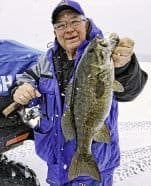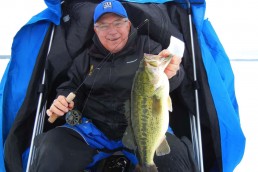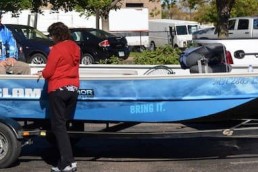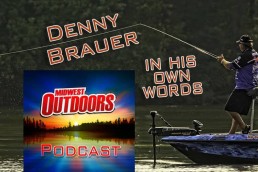In His Own Words … Dave Genz: Revolutionary Ice Man
SHARE THIS POST
Enough water has frozen and thawed enough times across the Ice Belt that a lot of anglers either don’t know, or have kind of forgotten, that ice fishing used to be a lot different than it is now. That was before Dave Genz seriously tinkered with it, every bit of it, and he and his friends dragged this sport into the modern age.
Most of the terms you hear repeated these days by modern ice fishing instructors first came out of Genz’s mouth: mobility, efficiency, underwater eyes (talking about using a flasher, with the transducer pointed down at your bait), mood indicator (diagnosing fish’s response to presentation on a flasher), dropper rigs, biters vs. sniffers, pounding, cadence, drop the rod tip, big moves vs. small moves, ice trolling, football fields and tennis courts, sticky-bottom areas, fishing fast, downviewing, and more.
What he did for our fishing fortunes was profound, including quitting a secure job to spend all his time traveling the northern U.S. and southern Canada, fishing and spreading the word that ice fishing can be just like open-water fishing, rather than something to do in the winter that often becomes a cozy card game and playing catch with a football.
The vision that he had, before we did, has come to pass. Many of us use the Winter Fishing System to actually fish through the ice, rather than waiting for it to melt before we get serious again. He didn’t just shake up ice fishing. He transformed the sport so completely that fundamental change of this magnitude will never happen again. As we get ready for another season on the ice, we present Dave Genz… In his own Words.
MidWest Outdoors: When it comes to modernizing ice fishing, among all the things you are known for, that curious-looking portable shelter called the Fish Trap probably tops the list. It was revolutionary when it appeared on the ice. Thinking back, how did anglers react to it then?
Dave Genz: People were ready for this style of fishing, of mobility. At that time, ice fishing was a waiting game, where you went out and waited for the fish to show up where you were, under your one hole in the ice. It was very few people who were already out there running and drilling multiple holes. There was still a lot of chopping holes in those days.
Moving around until you see fish, or maybe catch fish would be a better way to say it, because we didn’t have electronics on the ice yet, was not what ice fishermen did. But they were ready for it, they wanted it.
What the Fish Trap let us do was bring our equipment with us, and move around trying to find fish, rather than waiting for them to come to us. We were sort of blindly drilling holes. We had lake maps with us, but they were crude and inaccurate, but we wanted to become mobile, because it was better than just sitting there in one place all day.
MWO: One revelation that came while we were working on the Ice Revolution book––because we had never talked about it––was that you were not necessarily irritated with ice fishing in the old days. We might think your inventions were driven by frustration over how crude the sport was, but you were out there happily chasing down fish, right? In fact, you had a strategy for staying with schools of fish before the days of depthfinders. Tell us about that.
Genz: Yeah, we did. Let’s take crappies in deep holes. We’d catch a few, things would slow down, but we didn’t give up. We tried new holes. At least we understood that these schools of crappies were moving around in these deep holes, and we figured out how to find them.
Let’s say we were fishing down three-and-a-half arm lengths; that’s how we measured our depth back in those days. You had a bobber on your line, and you would be lowering your bait down, and when you were getting near the bottom, you’d keep lowering it, but you’d start shaking the jiggle stick [early ice rod]. The bobber is what you’d actually be shaking, and if it got two feet from the bottom and you caught a fish, you kinda knew you were in the center of the school. If you got all the way down and set [the bobber] on the water before you got a bite, you were on the edge.
We were fishing together, with several of us, which always helps when you’re scouting for fish. The guys who were catching fish that were higher off the bottom, then you knew you wanted to go that way when you drilled your next holes.
MWO: Staying on the move, what you called mobility, is perhaps the cornerstone of the modern ice fishing revolution. But you have often said that you think mobility has become a misunderstood term. What mistakes do we still make, when it comes to mobility?
Genz: Some people think mobility is going to a different lake than they did the day before, or just being able to get to the first spot. I see people with fish houses that are too big, that make it difficult to keep moving. They get everything out to the first spot, but don’t have a plan for what comes next if they don’t catch anything. I like to say, “how long does it take to catch nothing?” You have to keep moving, but do it through a combination of big moves and small moves. Big moves until you find fish, smaller moves after you start catching.
For a lot of people, the first thing they do is get a shovel out of their truck, and they start shoveling off a spot on the ice where they’re going to set up. No matter what kind of house they use, even a flip-over like the Fish Trap. They drill some holes, set up the house, get the shovel out and bank the fish house in, and they don’t even know if there’s fish there yet, in many cases. They spend a couple hours there and don’t catch anything, and then they say, “we better move.” So they move to another area, or another section of that same spot, and do the same process over again.
Mobility is, you gotta do this on a constant basis. If your Vexilar is telling you there aren’t any fish down there, you cannot say they’re not biting. You have to keep looking until there’s something down there, and then you can catch ‘em. I like to think of each hole as another cast, and the goal is to make as many casts as it takes to get on fish.
And back when mobility was really starting to be discussed, being the thing that you had to do, we saw a lot of people bragging that they drilled a hundred holes, but they were frustrated because they still didn’t catch as many fish as they wanted to. Drilling a bunch of holes, when you don’t check them all, is a lot of effort for nothing, and it’s really not mobility. We drill sets of holes at a time, and check them all, before moving on to drill more. We use what we learn from each set of holes to decide how far we’re going to go before drilling more, and in which direction we’re going to go next.
We’re doing this with a few people, and we all have one-person shelters, and a good auger, and good electronics, and we’re working together as a team. That’s how the holes multiply as the day goes along. It’s not that we drill a hundred holes in one spot. We drill maybe four, or six, at a time. To me, mobility means staying on the move until I have a red line on my Vexilar. I often say that my favorite fish to catch is a red line. I don’t really care what it is, just get me some red lines down there. And I’m not going to give up drilling holes until I find some fish to catch.
If you get over fish, that’s when you can use all the other parts of the system to catch them. And the clothing has made a big difference for this, too; it used to be more important to have the Fish Trap walls around you, because our clothes weren’t that good. When Ice Armor clothing came along [another development Genz had a hand in], we started talking about how we wearing our portable shelter. These days, I fish right off the seat of my snowmobile a lot, or fish standing up or kneeling outside. I mainly use the Fish Trap after I settle over fish, and on really cold and windy days.
Are you enjoying this post?
You can be among the first to get the latest info on where to go, what to use and how to use it!

MWO: We should clarify, too, that your Winter Fishing System makes the biggest difference when you’re trying to catch fishing during daylight hours, when ice anglers find ‘catching’ to be the most challenging.
Genz: Yes, and I always say that we all become better at catching fish when the sun hits the tops of the trees in the evening. That’s when you can sit there and let the fish come to you, because they’re on the move and feeding. But what are you going to do for the rest of the day?
During the daytime, there are only so many biters in any group of fish. Even when you locate a pod of fish, you catch the biters right away and then all of a sudden they become harder to catch, or you don’t catch any more. You can spend a lot of time downsizing, changing baits, and changing colors, to try to catch more fish out of that spot, or go drill another hole and find some more biters. That’s what the Winter Fishing System has always been about: finding aggressive fish. Finding aggressive fish, that are willing to bite.
A lot of times, we’re packing up when prime time comes, because we’ve been out there for a while and already caught a bunch of fish.
Genz through the years
November 28, 1947: Born, in St. Cloud, Minn.
1977: First took a depthfinder, a flasher, onto the ice and figured out how to level the transducer in order to see his bait on the display. This changed everything, because Genz could also see fish on the flasher, and began to figure out how to adjust the cadence of his presentation to match what the fish wanted.
1979: First of the early Dave Genz Fish Traps was created, sewn by hand by Genz’s wife, Patsy, who continued to sew every Trap for years until there were just too many to be done by hand.
1981: Developed first “Genz Box,” perfecting the use of sonar units for fishing. First ones were made of wood.
1982: First organized outing/competition for anglers fishing in Fish Traps and using the Winter Fishing System, on North Center Lake north of Minneapolis. Two years later, the events became more official and took on the name Trap Attack. Trap Attacks began as individuals competing to see who catch the biggest sunfish. Later, they expanded into other species and eventually became two-person team events with big cash prizes. Wooden plaques, originally made by Ed Laun of Spring Lake Park, Minnesota, because the biggest prize of all. Trap Attack entrants often said they were “fishing for the wood.”
1983: Crafted the first modern graphite ice rods, from broken fly rod tips.
1987: On his 40th birthday, November 28, Genz resigns from American Linen as a maintenance engineer and plunges headlong in the fishing industry on a full-time basis. He became the only full-time professional ice angler at the time, and remains the only one.
1992: As a key member of Team USA in the World Ice Fishing Championships held in Canada, won a Silver medal.
2002: Inducted into Minnesota Fishing Hall of Fame
2010: Enshrined in National Fresh Water Fishing Hall of Fame. It’s the Hall’s highest honor, given only to those “who have made a lasting national or world impact to the benefit of freshwater sportfishing.”
Yeah, but what has he caught lately?
Since the first Fish Trap rolled off the “garage assembly line,” Dave Genz has been relentlessly working on ideas that would improve the ancient sport of ice fishing. Things have changed, refined, moved forward at a steady pace.
These days, Genz fishes “outside” as much as in a shelter, using modern Ice Armor clothing as “shelter you wear,” as he says. He often fishes from the seat of his snowmobile, intently watching a Vexilar flasher rigged for quick deployment. A GPS unit mounted on the dash, showing digital contour maps, guides Genz right to where he will drill his next set of holes.
He punches holes, often as not, with a cordless drill fitted to a custom rig that transforms it into a lightweight but powerful auger. Everything about the gear and our understanding of ice fishing is better than it’s ever been, and Genz is still hard at it, traveling, fishing, making appearances at shows. He remains the only full-time professional ice angler, having long ago quit a steady job to bring the Winter Fishing System to the Ice Belt, one person at a time.
Hear the rest of the interview…
There’s much more to our conversation with fishing legend Dave Genz, and you’ll find it in the Podcast section at MidWestOutdoors.com. On the home page, look for the button that says Podcast, click on it, and you’ll find the Genz interview. We hope you have time to listen to some of our other feature interviews as well. We’ll see you there… it’s time well spent.
MWO
SHARE THIS POST
Did you enjoy this post?
You can be among the first to get the latest info on where to go, what to use and how to use it!
Mark Strand
MidWest Outdoors editorial director Mark Strand is a graduate of University of Minnesota School of Journalism with a minor in Fisheries & Wildlife Science. He has written for nearly every outdoor magazine over the past 41 years, and has written or co-written 14 books. In addition to writing and photography, Strand produces the MidWest Outdoors Podcast, and contributes to MWO digital properties. He is an outdoor generalist who loves hunting and fishing of all types. In 2018 Strand was elected to the Minnesota Fishing Hall of Fame.



